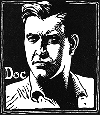 Doc Savage, the Man of Bronze. Among the best known of pulp heroes.
Doc Savage, the Man of Bronze. Among the best known of pulp heroes.
He is the pulp world’s Superman to The Shadow as Batman. (So does this make Street & Smith the DC Comics of the pulp world? Is Popular Publications the Marvel? Thrilling the Archie Comics?)
And the Superman analog is appropriate, as we know many elements of Doc Savage were mined by the Superman editors in the 1950s. They turned Superman into an all-round superhuman (making him a scientist, medical doctor, etc), with an arctic Fortress of Solitude and a female cousin with the same powers.
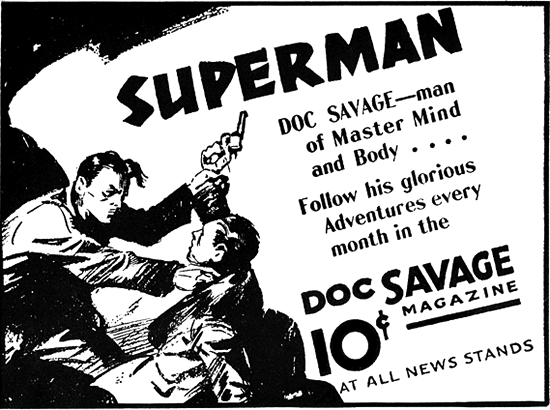
Most may not be clear about what led to Doc’s creation. After the success of The Shadow, the Street & Smith editors looked for further success. There was talk of reviving their old dime novel hero, Nick Carter. But S&S publisher Henry W. Ralston and editor John L. Nanovic created the basic outline for Doc, turning him over the Lester Dent to create the Doc Savage we know.
Interesting enough, they took elements from Nick Carter. Carter had been trained by his father from childhood to be a mental and physical marvel. (This is why when S&S revived Carter, they turned him into a more standard hardboiled detective, rather than the large-than-life character he had been). This new Nick Carter pulp came out at the same time as Doc Savage.
Lester Dent was a budding pulp author at the time. He had created several “gadget heroes” before getting the Doc assignment, and brought this element to the Doc Savage stories. Dent wrote many of the stories under the house name of “Kenneth Robeson“. I’ve never heard the origin of that name. Others also wrote Doc stories. Some as ghost writers for Dent, others directly for S&S.
Unlike The Shadow and other pulp heroes, Doc was more of a scientific adventurer, fighting against larger-than-life menaces. We learn that Doc from childhood until probably sometime in his 20s, was trained by a cadre of experts in a wide range of fields. He is pretty much an expert in all fields, but in particular he is a surgeon and scientist. He is also a physical marvel, exercising his body and mind for two hours each day. His skin is tanned, hence his being known as the “Man of Bronze”; his hair is bronze-like in color, a little darker than his skin; and his eyes are golden.
Doc was also assisted by a group of five experts, men he met during WWI. These men were his aides:
- Col. John “Renny” Renwick, a physically large man with huge fists who worked as a construction engineer on many big projects.
- Major “Long Tom” Roberts, an electrical engineer who looks like he is on his last leg, but is actually very tough.
- William Harper “Johnny” Littlejohn, a geologist and archaeologist who carries a monocle he uses as a magnifying lens. He is known for his big words.
- Brig. Gen. Theodore Marley “Ham” Brooks, a powerful lawyer known for his impeccable attire and his sword-cane. His nickname is from WWI, when he was framed for stealing hams.
- Lt. Col. Andrew Blodget “Monk” Mayfair, an industrial chemist who is almost simian in appearance, hence his nickname.
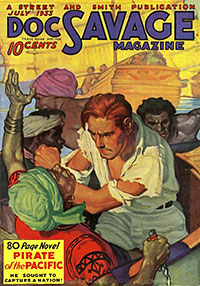 Monk and Ham are the most well-known aides, and, I believe, appeared in all novels, while the others did not, especially in the later stories. Monk and Ham are always bickering, though they are really friends. It’s interesting that with most Doc clones or pastiches, there is usually a couple of characters in the Monk and Ham model.
Monk and Ham are the most well-known aides, and, I believe, appeared in all novels, while the others did not, especially in the later stories. Monk and Ham are always bickering, though they are really friends. It’s interesting that with most Doc clones or pastiches, there is usually a couple of characters in the Monk and Ham model.
Another sort-of member of the group is Doc’s cousin, his only living relative, Pat Savage. She is very like her cousin in appearance, having the same eye and hair colors. She appeared in several stories, as she liked action. Most times she ran her high-priced spa, Patricia’s.
Doc’s headquarters is apparently on the 86th floor of the Empire State Building (never named, but seems obvious). He has a secret elevator, or “flearun,” that takes passengers to the Hidalgo Trading Co. warehouse on the Hudson River where Doc has his various planes, boats, and other vehicles, like his dirigible and submarine. In addition, Doc has his Fortress of Solitude in the Arctic where he retreats for study and learning. Doc also has a worldwide network of businesses, financed by gold from a hidden mine in Central America.
A variety of villains menaced Doc and his men. Most people know of the mysterious Russian John Sunlight, who was the only villain to come back for a second story. Most of the masterminds they dealt with usually came to a bad end. Their henchmen where sent to Doc’s “Crime College” in upstate New York to be trained into model citizens.
The pulp ran from 1933 to 1949, canceled when Street & Smith ended their pulps and comics. It lasted 181 issues. Most think the pre-WWII stories are best, being adventures with scientific elements, many involving lost worlds and civilizations.
The war-time stories have a different feel, as do the post-war ones, as they “de power” Doc to a certain extent. In fact, for a period Doc was more of a “science detective” (which his magazine was tagged as) than a science adventurer.
Comic Strips and Comic Books
Lester Dent tried to sell a Doc Savage comic strip, as he had the rights to do so. A week’s worth of samples were done, based on the “Sargasso Ogre.” Never picked up, the strips have been reprinted in a few places.
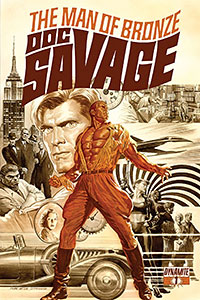 There have been several comic book series of Doc, some good, many bad. Street & Smith first used him in their comic books. He appeared in the back of The Shadow Comics, before getting his own title. The early stories were adaptations of the pulp stories, though only one used all the aides. The comics mainly had Ham and Monk (here usually shown as a bald bruiser with a unibrow), and sometimes adding a secretary for Doc.
There have been several comic book series of Doc, some good, many bad. Street & Smith first used him in their comic books. He appeared in the back of The Shadow Comics, before getting his own title. The early stories were adaptations of the pulp stories, though only one used all the aides. The comics mainly had Ham and Monk (here usually shown as a bald bruiser with a unibrow), and sometimes adding a secretary for Doc.
Then in the comic they turned him into a superhero, giving him a hood with a mystic ruby. For many stories, he was this way before they dropped the mystic ruby.
All the stories I’ve seen of the S&S comic book Doc are pretty bad. The only source I’ve seen for reprints have been in the Bronze Gazette fanzine, which has reprinted several stories over the years, though it has been awhile.
Gold Key Comics did a one-shot based on “The Thousand Headed Man,” meant as a tie-in to an unmade movie. I’ll delve more into it in a future posting.
Marvel Comics then got the rights and first did a color comic book that adopted pulp stories, two issues each, for a total of eight issues. This was recently reprinted by DC Comics. Then they came out with a black-and-white magazine that had original stories and was better done for eight issues. DC Comics reprinted this as part of their Showcase Presents series, and Dynamite will soon do an archive reprint.
DC Comics then got the rights and did a mini-series to bring Doc into the modern age, giving him a son and grandson. They later reprinted this. This kicked off an ongoing series, though toward the end they did a crossover with The Shadow, set in the 1930s.
Millennium Comics did a series of mini-series that I feel was the best color comic version of Doc Savage. This included a Manual of Bronze one-shot and a Pat Savage one-shot.
Dark Horse Comics next got the rights and did a few mini-series I felt were also good. Sadly neither the Millennium Comics or Dark Horse Comics have been reprinted in book form.
DC Comics got the rights again, and decided to set new stories of Doc and other characters in an “alternate universe” that was a bit confusing, called “First Wave.” Changes were made to Doc and his men that most people didn’t like, and it wasn’t a success. For me, the only decent story was the last one by J.G. Jones that sadly saw the last issue published only online.
Recently, Dynamite Comics has gotten the rights to Doc. Their first Doc series hasn’t been well received because each issue is a stand-alone story set in a different decade, with the goal to bring Doc into the modern age. But this is at the expense of getting to know Doc and his aides. They recently did an annual with a story set before the pulps, but many things were not true to the character. Dynamite is also reprinting the Marvel black-and-white magazine stories, but it’s unknown if they will reprint other material.
Radio
There were two short-lived Doc Savage radio shows during the pulp era. The first had stories written by Lester Dent. While I am not aware of any recordings existing, the scripts have been reprinted in a single volume from Moonstone Books. The second radio show was based on the mystic ruby-wearing Doc from the comics.
In the 1980s, NPR did two radio dramas based on pulp stories. These have finally been released on CD by Radio Archives.
Movies
Apparently Lester Dent also had the movie rights to Doc, but was never able to get a movie or movie serial done.
There was talk of a Doc movie in the 1960s, to star Chuck Connors, but other than the tie-in comic book, nothing came of it.
Most are aware of George Pal‘s “Doc Savage: The Man of Bronze” movie staring Ron Ely, best known for playing Tarzan. Most don’t like it for its campy elements. It is available on DVD through Warner Brothers Archive Collection. And there is a fan edit that removes many of the campy elements out there as well.
There have been rumors of a new movie project involving Shane Black, but I have heard nothing of late.
Reprints and new
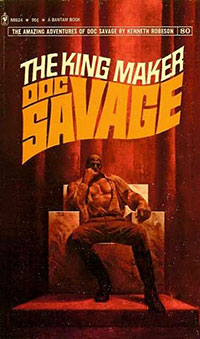 In the 1960s, Bantam Books started a reprint series of Doc Savage. They hired James Bama to create an iconic image of Doc Savage: a physical marvel in a ripped shirt. They added close cropped hair with a widow’s peak, which has become the modern view of Doc Savage. The reprint series was hugely popular, that led to reprints of other pulp heroes including The Shadow, The Spider, Operator #5, G-8, Phantom Detective, The Avenger, and others. Doc was one of the few to get a complete reprint, which is impressive considering the number of novels he had. They even found an unpublished novel and published it.
In the 1960s, Bantam Books started a reprint series of Doc Savage. They hired James Bama to create an iconic image of Doc Savage: a physical marvel in a ripped shirt. They added close cropped hair with a widow’s peak, which has become the modern view of Doc Savage. The reprint series was hugely popular, that led to reprints of other pulp heroes including The Shadow, The Spider, Operator #5, G-8, Phantom Detective, The Avenger, and others. Doc was one of the few to get a complete reprint, which is impressive considering the number of novels he had. They even found an unpublished novel and published it.
When Bantam ran out of reprints, they commissioned Philip José Farmer to write a new story telling how Doc and his aides met during WWI. This was followed by several new novels written by Doc researcher Will Murray based on unused story outlines by Lester Dent. So in additional to a complete reprint, Doc is also one of the few copyrighted pulp heroes who has gotten new stories.
Since then, Sanctum Books has started a reprint series, with two or three novels per volume and the original covers. These volumes also include restored text on some stories, and explanatory articles. Close to 80 volumes are out so far. And recently Will Murray started writing more new stories, now published by Altus Press, which is also reprinting the prior new stories from Murray.
Now is a great time to get into Doc Savage.

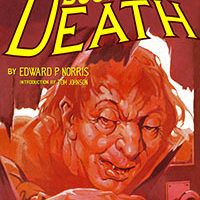
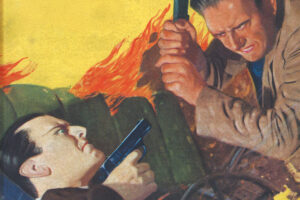
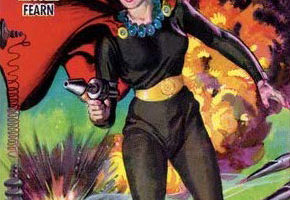
There’s several things not to like about Dynamite’s current comic book series (which I believe is ending at #8). Doc is still pretty much a cipher, but the main thing I don’t like is that Doc isn’t fighting criminal masterminds anymore. Instead he’s basically cleaning up other peoples’ mistakes.